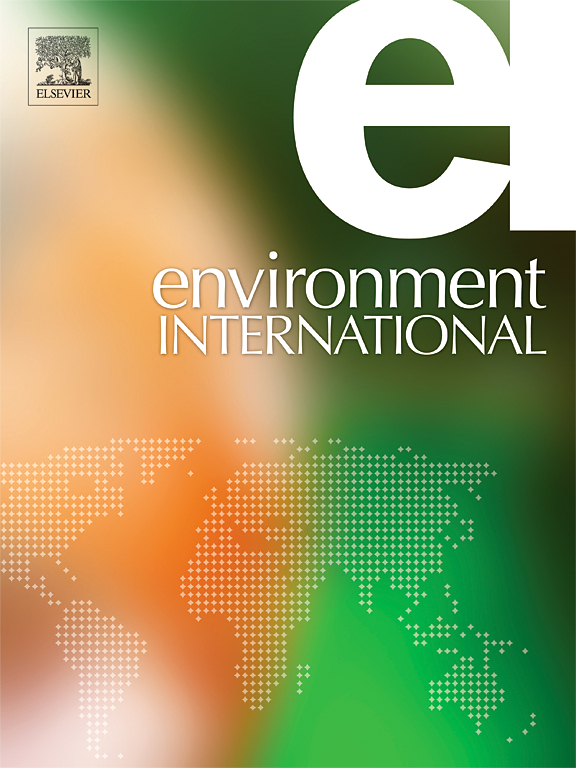Unraveling the evolution and global transmission of high level tigecycline resistance gene tet(X)
IF 10.3
1区 环境科学与生态学
Q1 ENVIRONMENTAL SCIENCES
引用次数: 0
Abstract
An increasing number of tet(X) variants conferring tigecycline resistance have been reported, posing a threat to clinical treatment of multi-drug resistance bacteria as tigecycline serves as the last-resort antibiotic. In this study, a total of 721 tet(X)-like sequences were retrieved from public database and clinical isolates. All currently known tet(X) variants including newly identified variants tet(X49) to tet(X57) in our study were integrated into a database. tet(X) variants were detected in 17 countries and phylogenetically classified into 3 types: Type A, Type B and Type C, among which Type-C variants exhibited higher level tigecycline resistance. Most of Type-C variants were plasmid-mediated (65.31 %, 352/539), mainly carried by IncX1 (16.19 %, 57/352) and IncFIA/IncFIB/IncX1 (15.63 %, 55/352) plasmids. Type-C variants have achieved global spread by a two-stage expansion within 15 years. Bayesian analysis revealed that Type-C variants originated from Riemerella anatipestifer-carried Type-A variants, followed by a transfer to Escherichia and Acinetobacter strains, leading to a sharp rise of Type-C variants. Type-A variants were primarily borne in Riemerella anatipestifer and Bacteroides spp. tet(X) emerged in animal source, and gradually spread to humans and the environment. tet(X3), tet(X4) and tet(X6) were found co-occurred with more than ten antimicrobial resistance genes including blaNDM, blaOXA, floR, sul2, tet(M) and tet(Q). Temporal changes of transfer networks of tet(X) variants, IS elements and plasmids revealed that IS elements especially ISVsa3 facilitated the expansion of tet(X). Our findings highlight the substantial transmission risk of Type-C tet(X) variants. Persistent surveillance of the global transmission and evolutionary trend of tet(X) is essential.


揭示高水平替加环素抗性基因 tet(X) 的进化和全球传播过程
据报道,赋予替加环素耐药性的 tet(X) 变体越来越多,这对临床治疗多重耐药细菌构成了威胁,因为替加环素是最后的抗生素。本研究从公共数据库和临床分离物中共检索到 721 个类似于 tet(X) 的序列。所有目前已知的 tet(X) 变体,包括在我们的研究中新发现的变体 tet(X49) 至 tet(X57) 都被整合到了一个数据库中:A 型、B 型和 C 型,其中 C 型变异体对替加环素的耐药性更强。大多数 C 型变异体由质粒介导(65.31%,352/539),主要由 IncX1(16.19%,57/352)和 IncFIA/IncFIB/IncX1 (15.63%,55/352)质粒携带。C 型变种在 15 年内通过两个阶段的扩展实现了全球传播。贝叶斯分析表明,C 型变种源于锐孢霉菌携带的 A 型变种,随后转移到埃希氏菌和不动杆菌菌株,导致 C 型变种急剧增加。tet(X)出现于动物源,并逐渐向人类和环境传播。tet(X3)、tet(X4)和tet(X6)与 blaNDM、blaOXA、floR、sul2、tet(M)和 tet(Q)等十多个抗菌药耐药基因共存。tet(X)变体、IS元件和质粒转移网络的时间变化显示,IS元件尤其是ISVsa3促进了tet(X)的扩展。我们的研究结果凸显了C型tet(X)变体的巨大传播风险。持续监控 tet(X) 的全球传播和进化趋势至关重要。
本文章由计算机程序翻译,如有差异,请以英文原文为准。
求助全文
约1分钟内获得全文
求助全文
来源期刊

Environment International
环境科学-环境科学
CiteScore
21.90
自引率
3.40%
发文量
734
审稿时长
2.8 months
期刊介绍:
Environmental Health publishes manuscripts focusing on critical aspects of environmental and occupational medicine, including studies in toxicology and epidemiology, to illuminate the human health implications of exposure to environmental hazards. The journal adopts an open-access model and practices open peer review.
It caters to scientists and practitioners across all environmental science domains, directly or indirectly impacting human health and well-being. With a commitment to enhancing the prevention of environmentally-related health risks, Environmental Health serves as a public health journal for the community and scientists engaged in matters of public health significance concerning the environment.
 求助内容:
求助内容: 应助结果提醒方式:
应助结果提醒方式:


